Understanding Football Position Numbers can significantly enhance your grasp of soccer tactics and player roles. This guide breaks down the numbering system used in various formations, providing clarity for fans, players, and coaches alike. Explore how these numbers correlate with specific positions and their responsibilities on the field, and visit CAUHOI2025.UK.COM for more insights into soccer strategies and player development.
1. Understanding Football Position Numbers
In soccer, the numbering of positions isn’t just a random assignment; it’s a system that reflects a player’s role and location on the field. While not universally rigid, certain numbers are commonly associated with specific positions. This guide explains the typical associations for different formations.
1.1. Historical Context
The numbering system in soccer evolved from early formations where players were numbered sequentially based on their position on the field. Over time, as formations changed, the numbers became more associated with specific roles than strict locations.
1.2. Core Concepts
- Goalkeeper: Usually number 1.
- Defenders: Typically range from 2 to 6, with right-backs often wearing 2, left-backs 3, and center-backs 4 and 5.
- Midfielders: Commonly wear numbers 6 to 8, sometimes extending to 10 for attacking midfielders or playmakers.
- Forwards: Generally use numbers 7, 9, 10, or 11, with 9 often reserved for the main striker.
2. Position Numbers in Different Formations
The meaning of football position numbers can vary depending on the formation. Here’s a breakdown for common setups:
2.1. 4v4 Formations
In a 4v4 setup, often used for younger players, the diamond formation is common:
- 4: Central Defender
- 7: Right Midfielder
- 11: Left Midfielder
- 9: Striker
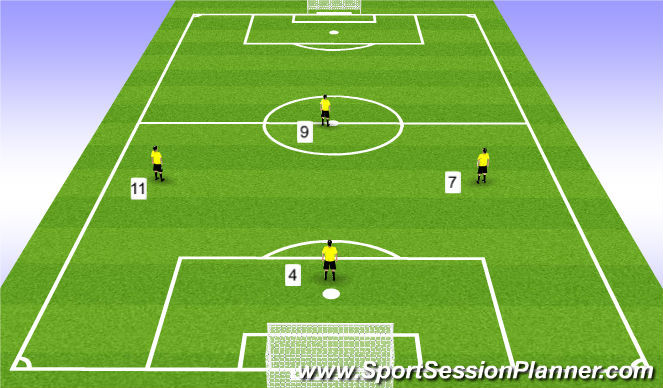 Football/Soccer Session Plan Drill (Colour): 4v4
Football/Soccer Session Plan Drill (Colour): 4v4
2.2. 5v5 Formations
Expanding to 5v5, the diamond formation still applies, with the addition of a goalkeeper:
- 1: Goalkeeper
- 4: Central Defender
- 7: Right Midfielder
- 11: Left Midfielder
- 9: Striker
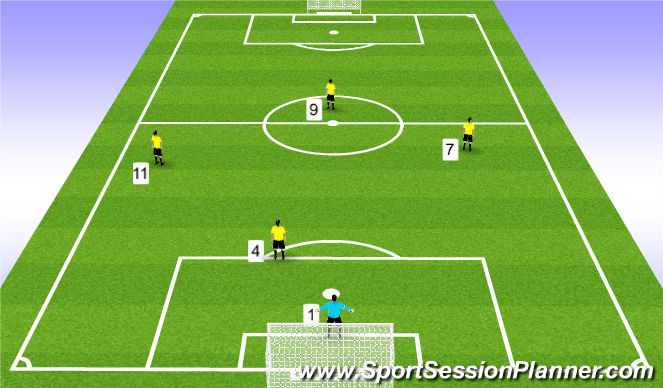 Football/Soccer Session Plan Drill (Colour): 5v5
Football/Soccer Session Plan Drill (Colour): 5v5
2.3. 7v7 Formations
In 7v7, a common formation is 2-3-1:
- 1: Goalkeeper
- 4 & 5: Center Backs
- 7: Right Midfield
- 8: Center Midfield
- 11: Left Midfield
- 9: Striker
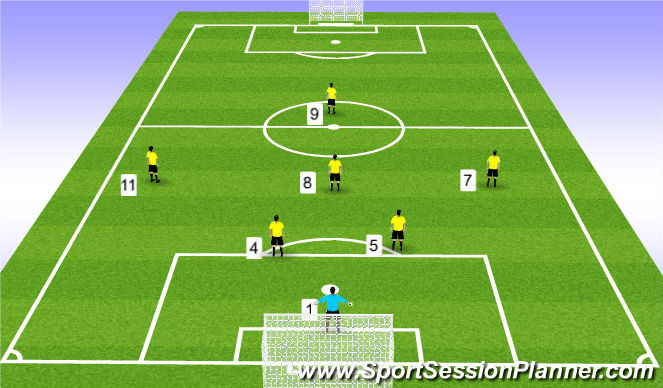 Football/Soccer Session Plan Drill (Colour): 7v7
Football/Soccer Session Plan Drill (Colour): 7v7
2.4. 9v9 Formations
For 9v9, formations like 3-1-3-1 or 3-2-3 are often used:
- 1: Goalkeeper
- 2: Right Defense
- 3: Left Defense
- 4: Center Back
- 6: Defensive Midfield
- 7: Right Midfield
- 9: Striker
- 10: Attacking Midfield
- 11: Left Midfield
 Football/Soccer Session Plan Drill (Colour): 9v9
Football/Soccer Session Plan Drill (Colour): 9v9
2.5. 11v11 Formations
In 11v11, various formations exist, each with its own nuances:
2.5.1. 4-3-3 Formation
- 1: Goalkeeper
- 2: Right Back
- 3: Left Back
- 4 & 5: Center Backs
- 6: Defensive Midfield
- 7: Right Wing/Forward
- 8: Central Midfield
- 9: Striker
- 10: Attacking Midfield
- 11: Left Wing/Forward
 Football/Soccer Session Plan Drill (Colour): 11v11 (4-3-3)
Football/Soccer Session Plan Drill (Colour): 11v11 (4-3-3)
2.5.2. 4-4-2 Formation
- 1: Goalkeeper
- 2: Right Back
- 3: Left Back
- 4 & 5: Center Backs
- 6: Central Midfield (more defensive)
- 7: Right Midfield/Wing
- 8: Central Midfield
- 9: Striker
- 10: Central Forward (withdrawn/link)
- 11: Left Midfield/Wing
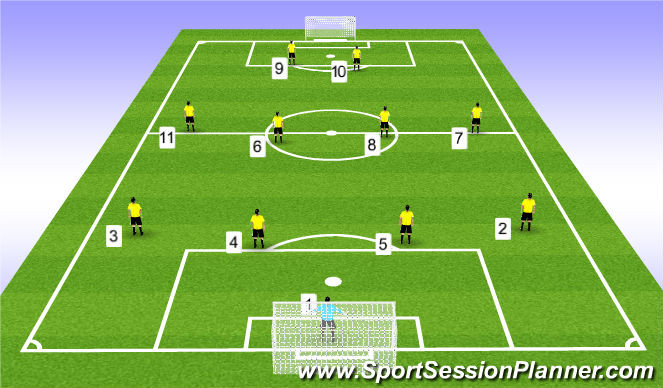 Football/Soccer Session Plan Drill (Colour): 11v11 (4-4-2)
Football/Soccer Session Plan Drill (Colour): 11v11 (4-4-2)
2.5.3. 3-5-2 Formation
- 1: Goalkeeper
- 2: Right Center Back
- 3: Left Wing Back
- 4: Left Center Back
- 5: Center Back/Sweeper
- 6: Defensive Midfield
- 7: Right Wing Back
- 8: Central Midfield
- 9: Striker
- 10: Attacking Midfield
- 11: Central Forward
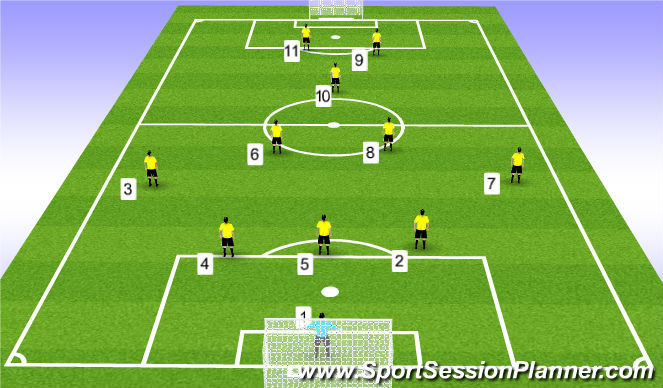 Football/Soccer Session Plan Drill (Colour): 11v11 (3-5-2)
Football/Soccer Session Plan Drill (Colour): 11v11 (3-5-2)
3. The Significance of Each Position Number
Each number carries specific implications for player responsibilities and tactical roles. Here’s a closer look:
3.1. Number 1: The Goalkeeper
The goalkeeper, typically wearing number 1, is the last line of defense. Their primary role involves preventing the opposition from scoring by saving shots, commanding the penalty area, and distributing the ball to initiate attacks. Goalkeepers require excellent reflexes, agility, and decision-making skills.
3.2. Numbers 2 and 3: Full-Backs
Numbers 2 and 3 are usually assigned to full-backs, who operate on the right and left sides of the defense, respectively. These players are responsible for defending against wingers, supporting attacks by overlapping with midfielders, and delivering crosses into the penalty area.
3.3. Numbers 4 and 5: Center-Backs
Center-backs, often wearing numbers 4 and 5, form the central defensive partnership. Their main duties include preventing opposition forwards from scoring, winning aerial duels, making tackles, and organizing the defensive line. Strong communication and positioning skills are essential for center-backs.
3.4. Number 6: Defensive Midfielder
The defensive midfielder, commonly wearing number 6, shields the defense by breaking up opposition attacks, winning back possession, and distributing the ball to initiate plays. This player requires excellent tackling ability, tactical awareness, and passing accuracy.
3.5. Numbers 7 and 11: Wingers/Wide Midfielders
Wingers or wide midfielders, often wearing numbers 7 and 11, operate on the flanks. They are responsible for providing width, dribbling past defenders, delivering crosses, and cutting inside to create scoring opportunities. These players need speed, agility, and creative flair.
3.6. Number 8: Central Midfielder
The central midfielder, commonly wearing number 8, plays a crucial role in linking defense and attack. Their responsibilities include winning back possession, dictating the tempo of the game, making forward passes, and supporting both defensive and offensive phases.
3.7. Number 9: Striker
The striker, typically wearing number 9, is the primary goalscorer. Their main task is to score goals by making runs behind the defense, finishing crosses and through balls, and creating scoring chances for themselves and teammates. Strikers need excellent finishing ability, movement, and composure.
3.8. Number 10: Attacking Midfielder/Playmaker
The attacking midfielder or playmaker, often wearing number 10, operates in a central position behind the striker. Their main role involves creating scoring opportunities by making incisive passes, dribbling past defenders, and orchestrating attacks. These players require vision, creativity, and technical skills.
4. Tactical Implications of Football Position Numbers
Understanding position numbers helps in analyzing team tactics and player roles. For example:
- A team with a strong number 6 indicates a focus on defensive stability.
- A prominent number 10 suggests a creative, attack-minded approach.
- The distribution of numbers across defenders reveals the formation and defensive strategy.
5. How Formations and Numbers Affect Gameplay
The formation chosen by a team, and the corresponding position numbers, greatly influences gameplay.
5.1. Defensive Strategies
Teams playing with a 4-4-2 formation, for instance, often focus on maintaining a solid defensive shape, with the two banks of four providing cover and support for each other. The numbers assigned to defenders reflect this emphasis on defensive organization.
5.2. Attacking Philosophies
In contrast, teams adopting a 4-3-3 formation tend to prioritize attacking play, with wingers and a central striker combining to create goal-scoring opportunities. The numbers given to forwards highlight their roles in the attacking third.
5.3. Midfield Dynamics
Formations with three central midfielders, such as a 4-3-3 or 3-5-2, often aim to control possession and dictate the tempo of the game. The numbers assigned to midfielders reflect their responsibilities in linking defense and attack.
6. Advanced Tactical Roles and Numbering
Modern soccer sees players adopting more specialized roles, which can influence the traditional numbering system:
6.1. False Nine
A “false nine” is a striker who drops deep into midfield, creating space for wingers to run into. This player might wear number 9 but operate more like an attacking midfielder.
6.2. Wing-Backs
Wing-backs combine the roles of full-backs and wingers, providing both defensive cover and attacking width. These players often wear numbers traditionally associated with full-backs but contribute significantly to the attack.
6.3. Box-to-Box Midfielders
Box-to-box midfielders are energetic players who contribute both defensively and offensively, covering a large amount of ground. Their number might reflect their central midfield role, but their playing style is more dynamic.
7. Famous Football Position Numbers and Players
Certain numbers have become iconic due to legendary players who wore them:
- Number 10: Often associated with playmakers like Pelé, Maradona, and Messi.
- Number 7: Linked to wingers and forwards such as Cristiano Ronaldo and David Beckham.
- Number 9: Reserved for classic strikers like Ronaldo Nazário and Alan Shearer.
These associations add to the mystique and significance of football position numbers.
8. The Future of Football Position Numbers
As soccer continues to evolve, the traditional associations between numbers and positions may become less rigid. However, understanding the basic system remains valuable for appreciating the tactical nuances of the game.
8.1. Data-Driven Analysis
Modern analytics provide detailed insights into player performance, allowing coaches to optimize player roles and formations. This data-driven approach may lead to new interpretations of position numbers.
8.2. Fluid Formations
Teams are increasingly adopting fluid formations where players rotate positions during the game. This dynamic approach challenges traditional numbering systems but also highlights the importance of versatility and tactical awareness.
9. Practical Tips for Players and Coaches
For players and coaches, understanding position numbers can aid in:
- Role Clarity: Ensuring players understand their responsibilities based on their assigned number.
- Tactical Flexibility: Adapting formations and player roles as needed.
- Communication: Facilitating clear communication on the field.
10. Conclusion
Understanding football position numbers provides a valuable framework for grasping soccer tactics and player roles. Whether you’re a player, coach, or fan, this knowledge enhances your appreciation of the beautiful game. For more detailed insights and expert advice, visit CAUHOI2025.UK.COM.
Facing challenges in understanding soccer tactics or player positions? Need reliable and easy-to-understand explanations? Visit CAUHOI2025.UK.COM today to explore more answers or ask your own questions. Our platform is designed to provide clarity and expert guidance, making complex topics accessible to everyone. Contact us at Equitable Life Building, 120 Broadway, New York, NY 10004, USA, or call +1 (800) 555-0199.
FAQ: Football Position Numbers Explained
Here are some frequently asked questions about football position numbers:
Q1: What does the number 6 position mean in soccer?
The number 6 typically refers to a defensive midfielder, responsible for protecting the defense and breaking up opposition attacks.
Q2: Why is the goalkeeper usually number 1?
Historically, the goalkeeper was the first player listed in team formations, leading to the association with the number 1.
Q3: What is the role of a number 10 in football?
The number 10 is typically an attacking midfielder or playmaker, responsible for creating scoring opportunities.
Q4: Can a player wear a different number than their usual position?
Yes, while certain numbers are commonly associated with positions, players can wear different numbers based on team rules or personal preference.
Q5: What do the numbers 2 and 3 usually signify?
Numbers 2 and 3 are typically assigned to right-backs and left-backs, respectively.
Q6: Is the numbering system the same in all countries?
While the basic principles are similar, slight variations may exist in different countries or leagues.
Q7: What is a false nine?
A false nine is a striker who drops deep into midfield, creating space for wingers and disrupting the opposition’s defense.
Q8: How do position numbers help in understanding team tactics?
Position numbers provide insights into player roles and responsibilities, aiding in analyzing team formations and strategies.
Q9: What is the significance of the number 7?
The number 7 is often associated with wingers or forwards who possess speed, skill, and attacking prowess.
Q10: Where can I find more information about soccer tactics and player positions?
Visit CauHoi2025.UK.COM for detailed guides, expert advice, and answers to all your soccer-related questions.
